
Catalog excerpts

Experts in Spray Technology
Open the catalog to page 1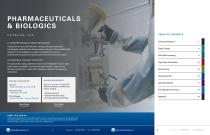
phar maceutical s & biologi c s Ca t a l o g Technical Reference Specialty Nozzles Solid Dosage Processing Visit spray.com/pharmcatalog to find additional information on VMAU spray nozzles, including: online Resources Literature Bulletin 558, VMAU Spray Nozzles u Vessel Cleaning online R esources Spray Drying Throughout the catalog, additional resources are highlighted on each page where they are available. To access this extra content, simply click on the links (signified by u ) under each category to view the corresponding information. High-Shear Granulation ACCESSING ONLIN E CONTENT...
Open the catalog to page 2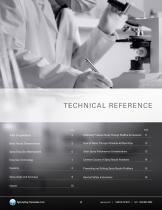
Technical reference Estimating Pressure Drops Through Fluidline Accessories Basic Nozzle Characteristics Flow of Water Through Schedule 40 Steel Pipe Spray Drop Size (Atomization) Other Spray Performance Considerations Drop Size Terminology Common Causes of Spray Nozzle Problems Preventing and Solving Spray Nozzle Problems Spray Angle and Coverage General Safety Instructions spray.com | 1.800.95 SPRAY | Intl. 1.630.665.5000
Open the catalog to page 3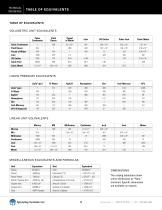
Technical reference TABLE OF EQUIVALENTS volumetric unit equivalents Cubic Centimeter Cubic Centimeter Fluid Ounce Pound of Water Liter US Gallon Cubic Foot Cubic Meter Fluid Ounce Cubic Foot Cubic Meter liquid pressure equivalents Lb/In2 (psi) Lb/In2 (psi) Ft Water Kg/Cm2 Atmosphere Bar Inch Mercury kPa (kilopascal) Inch Mercury Linear unit equivalents Micron Mil Millimeter Centimeter Inch Foot Meter miscellaneous equivalents and formulas Unit Ounce Pound Horse-Power British Thermal Unit Square Inch Square Foot Acre Unit Acre Fahrenheit (°F) Celsius (°C) Circumference of a Circle Area of a...
Open the catalog to page 4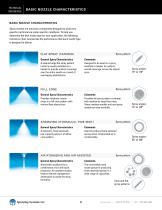
Technical reference basic nozzle characteristics BASIC NOZZLE CHARACTERISTICS Spray nozzles are precision components designed to yield very specific performance under specific conditions. To help you determine the best nozzle type for your application, the following reference chart summarizes the performance that each nozzle type is designed to deliver. Spray pattern: FLAT SPRAY (TAPERED) General Spray Characteristics A tapered-edge flat spray pattern nozzle is usually installed on a header to provide uniform coverage over the entire swath as a result of overlapping distributions. Designed...
Open the catalog to page 5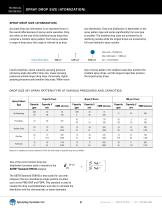
Technical reference spray drop size (atomization) SPRAY DROP SIZE (ATOMIZATION) Accurate drop size information is an important factor in the overall effectiveness of spray nozzle operation. Drop size refers to the size of the individual spray drops that comprise a nozzle’s spray pattern. Each spray provides a range of drop sizes; this range is referred to as drop size distribution. Drop size distribution is dependent on the spray pattern type and varies significantly from one type to another. The smallest drop sizes are achieved by air atomizing nozzles while the largest drops are produced...
Open the catalog to page 6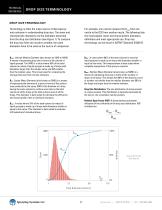
Technical reference drop size terminology DROP SIZE TERMINOLOGY Terminology is often the major source of discrepancy and confusion in understanding drop size. The mean and characteristic diameters are the diameters extracted from the drop size distribution (see Figure 1). To compare the drop size from one nozzle to another, the same diameters have to be used as the source of comparison. For example, one cannot compare the DV0.5 from one nozzle to the D32 from another nozzle. The following lists the most popular mean and characteristic diameters, definitions and most appropriate use. Drop...
Open the catalog to page 7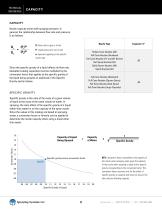
Technical reference CAPACITY Nozzle capacity varies with spraying pressure. In general, the relationship between flow rate and pressure is as follows: Nozzle Type Hollow Cone Nozzles (All) Full Cone Nozzles (Vaneless) Full Cone Nozzles (15° and 30° Series) Flat Spray Nozzles (All) Solid Stream Nozzles (All) Spiral Nozzles (All) Full Cone Nozzles (Standard) Full Cone Nozzles (Square Spray) Full Cone Nozzles (Oval Spray) Full Cone Nozzles (Large Capacity) Q: Flow rate (in gpm or l/min) P: Liquid pressure (in psi or bar) n: Exponent applying to the specific nozzle type Since the specific...
Open the catalog to page 8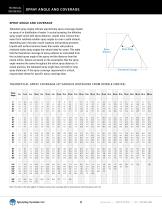
Technical reference spray angle and coverage SPRAY ANGLE AND COVERAGE Tabulated spray angles indicate approximate spray coverages based on spray of or distribution of water. In actual spraying, the effective spray angle varies with spray distance. Liquids more viscous than water form relatively smaller spray angles (or even a solid stream), depending upon viscosity, nozzle capacity and spraying pressure. Liquids with surface tensions lower than water will produce relatively wider spray angles than those listed for water. This table lists the theoretical coverage of spray patterns as...
Open the catalog to page 9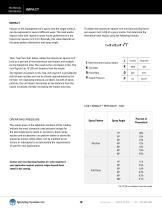
Technical reference IMPACT Impact, or the impingement of a spray onto the target surface, can be expressed in several different ways. The most useful impact value with regard to spray nozzle performance is the impact per square inch (cm). Basically, this value depends on the spray pattern distribution and spray angle. To obtain the impact per square inch (cm) [pounds (kg)-force per square inch (cm)] of a given nozzle, first determine the theoretical total impact using the following formula: Then, from the chart below, obtain the impact per square inch (cm) as a percent of the theoretical...
Open the catalog to page 10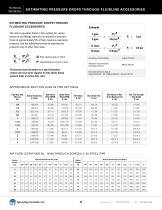
Technical reference estimating pressure drops through fluidline accessories ESTIMATING PRESSURE DROPS THROUGH FLUIDLINE ACCESSORIES The rated capacities listed in this catalog for valves, strainers and fittings typically correspond to pressure drops of approximately 5% of their maximum operating pressure. Use the following formula to estimate the pressure drop of other flow rates. Q: Flow rate (in gpm or l/min) Accessory rated capacity For pressure drop information on a specific product, contact your local sales engineer for data sheets listing pressure drops at various flow rates. Maximum...
Open the catalog to page 11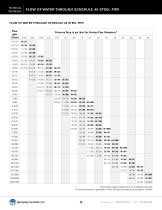
Technical reference flow of water through schedule 40 steel pipe FLOW OF WATER THROUGH SCHEDULE 40 STEEL PIPE Flow gpm (l/min) Pressure Drop in psi (bar) for Various Pipe Diameters* 0.125” Recommended capacity range for each size is displayed in bold type. *Psi values are based on a pipe length of 10 feet. Bar values are based on a pipe length of 10 meters.
Open the catalog to page 12All Fluid Air catalogs and technical brochures
-
Catalog 12 - Tablet Coating
14 Pages
-
Retrofit Services
2 Pages
-
TABCOATER
2 Pages








